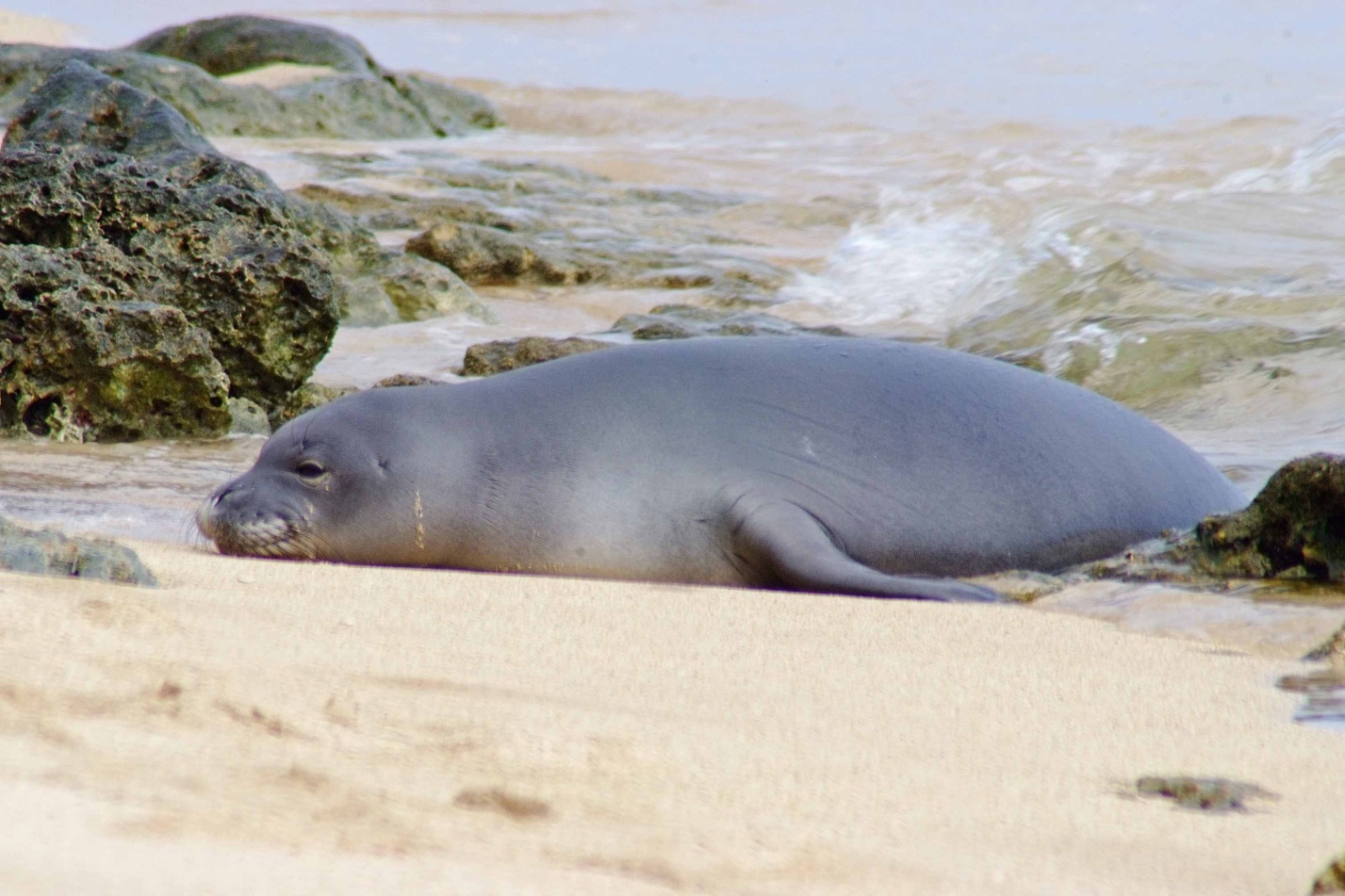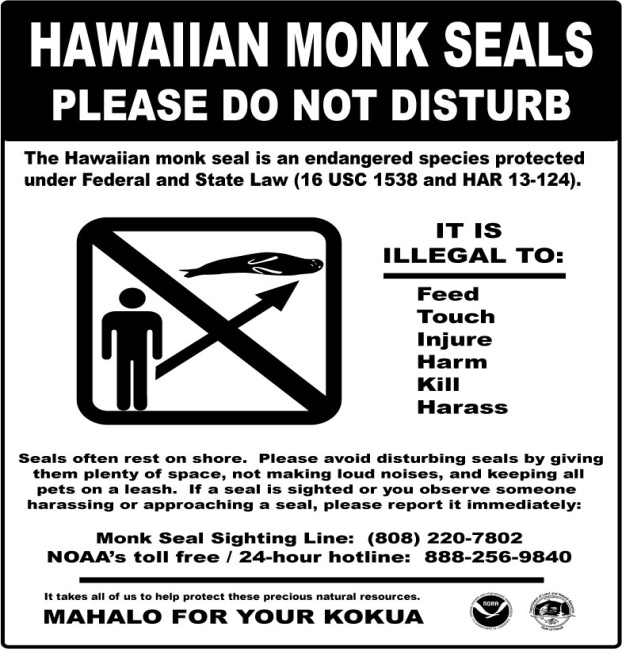Survey for individuals
Hawaiian Monk Seal: Public Knowledge and Opinion Survey
Survey for Individuals Booklet
Individual intercept surveys
OMB: 0648-0617
Ilio holo ikauaua
Public Opinion Survey
Survey for Individuals

Your participation in this survey is voluntary. Any material that might identify you will be destroyed at the end of the study.
OMB Control #: XXXX-XXXX
Expiration Date: xx/xx/xxxx
This survey is being conducted to gather information on the public’s knowledge and opinions about wild Hawaiian monk seals (Ilio holo ikauaua; Monachus schauinslani). The questions in this survey are about the Hawaiian monk seal in the wild rather than monk seals in public display facilities (i.e., zoos and aquaria). Throughout this survey all references to monk seals mean Hawaiian monk seals. The results of the survey will be used to help develop public outreach activities for wild Hawaiian monk seal conservation and to help develop and assess management strategies for dealing with human-seal interactions. Your participation will help provide valuable information.
Have you ever personally seen a monk seal in the wild in Hawai‘i (outside of zoos and aquaria)?
|
Yes (Go to Q 2) |
|
No (Go to Q 4) |
If you have seen monk seals in the wild, how many different times have you seen them in the past five years? (Mark one)
1 time |
2-5 times |
6-10 times |
More than 10 times |
If you have seen a monk seal in the wild, where? (Mark all that apply)
-
Seal was on the beach
Seal was in the water
I was on the beach
I was in the water (swimming, snorkeling, diving, etc.)
I was on a commercial tour
I was in a personal /non-commercial boat or other type of watercraft
Don’t know
Other (Please describe)____________________
WHAT DO PEOPLE KNOW ABOUT MONK SEALS?
What is your level of knowledge about the Hawaiian monk seal?
No knowledge |
Small amount |
Moderate amount |
Large amount |
Do you think monk seals are native to the Hawaiian Islands?
-
Yes
No
Not sure
Do you think the population of Hawaiian monk seals in general has been increasing or decreasing over the past twenty years?
Significant decrease |
Slight decrease |
Stable (neither increasing nor decreasing) |
Slight increase |
Significant increase |
Not sure |
Hawaiian monk seals are legally protected under Federal and State laws.
Prior to this survey, were you aware of any legal protections in place for the Hawaiian monk seal?
-
Yes (Go to Q 8)
No (Go to Q 9)
How well do you think the monk seal is protected under current regulations?
Not at all protected |
Protected, but not enough |
Well protected |
Over protected |
Not sure |
Do you agree or disagree with the following statement: Protection of the Hawaiian monk seal is NOT very important because there are many types of seals throughout the world.
Strongly disagree |
Disagree |
Neither agree nor disagree |
Agree |
Strongly agree |
Not sure |
Are you familiar with the Endangered Species Act?
-
Never heard of it (Go to Q 12)
Heard of it, but don’t know much about it
Somewhat familiar
Very familiar
Do you think that violations of the Endangered Species Act are regularly enforced?
-
Yes
No
Not sure
HUMAN-MONK SEAL INTERACTIONS
People have different opinions about what is considered appropriate behavior around wildlife. Which of the following, if any, do you consider appropriate behavior regarding monk seals? (Mark all that apply)
-
Viewing monk seals from 100 ft away
Viewing monk seals from 10 ft away
Approaching monk seals within 10 ft on land
Touching monk seals
Feeding monk seals
Swimming close to monk seals
Shooting at or around monk seals
Photographing monk seals
Fishing around monk seals
Yelling, or making other very loud noises around monk seals
Trying to scare monk seals away
Allowing dogs to approach and/or interact with monk seals
Do you think it is dangerous for people to approach monk seals on land?
-
Yes, for the person only
Yes, for the seal only
Yes, for both the person and the seal
No, if the seal is used to being around people
No, I think it is safe
Depends on the situation
Don’t know / Not sure
Do you think it is dangerous for people to swim with or be in close contact in the water with monk seals?
-
Yes, for the person only
Yes, for the seal only
Yes, for both the person and the seal
No, if the seal is used to being around people
No, I think it is safe
Depends on the situation
Don’t know / Not sure
If you encountered a monk seal while you were on land, what do you think you would do? (Mark all that apply)
-
Touch it
Report sighting to lifeguard
Report sighting to authorities
Do nothing
Other (Please describe) __________________________
Don’t know / Not sure
If you encountered a monk seal while you were in the water, what do you think you would do? (Mark all that apply)
-
Swim away
Swim close to it without touching it
Touch it
Report sighting to lifeguard
Report sighting to authorities
Do nothing
Other (Please describe) __________________________
Don’t know / Not sure
Do you think that it is dangerous for dogs to interact with monk seals?
-
Yes, for the dog only
Yes, for the seal only
Yes, for both the dog and the seal
No, I think they can interact safely
Depends on the dog
Don’t know/ Not sure
If you encountered a live monk seal tangled in a net, how would you be likely to respond? (Mark all that apply)
-
Do nothing
Try to cut it free
Call the authorities
Don’t know/Not sure
Other (Please describe) _____________________
Do you know which authorities to report monk seal sightings to?
-
Yes (Please describe) ______________________
No
FISHING AND MONK SEALS
Do you or any family members in your household fish on a regular basis?
-
Yes (Go to Q 21)
No (Go to Q 27)
If you any family members in your household fish on a regular basis, we would like to know why. (Mark all that apply)
-
Fish to provide food for my family
Fish to provide income
Fish for recreation/sport only
Fish for recreation/sport and sometimes keep part of my catch to eat
Fish for recreation/sport and sometimes sell part of my catch
Other (Please describe) _____________________
Do you think that if monk seals are present in an area where you are fishing, you catch less fish?
-
Yes
No
Not sure
Other (Please describe) _____________________
Do you think that if the number of monk seals increases, you would catch less fish?
-
Yes
No
Not sure
Other (Please describe) _____________________
If you were fishing and a monk seal became hooked on a fishing line how would you likely respond? (Mark all that apply)
-
Cut the line
Try to get the hook free in some way
Call the authorities
Try to scare it away
Don’t know/Not sure
Other (Please describe) _____________________
Would you be willing to use hooks without barbs while fishing in order to reduce the possibility of hooks becoming stuck in the mouths of monk seals?
-
Yes
No
Only if required by law
Only in areas where monk seals are present
Not sure
Do believe that using hooks without barbs would affect fish catch?
-
Yes
No
Only for certain types of fish
Not sure
People have various opinions about whether fishing should be regulated to protect monk seals.
Do you agree or disagree that regulations for recreational hook and line fishing in the main Hawaiian Islands should be enacted SPECIFICALLY to reduce or prevent monk seals from becoming hooked?
Strongly disagree |
Disagree |
Agree |
Strongly agree |
Not sure |
RESTRICTING HUMAN ACTIVITY AROUND MONK SEALS
Do think certain human activities should be prohibited around monk seals?
-
Yes (Go to Q 29)
No (Go to Q 30)
Not sure (Go to Q 29)
Do you think that any of the following human activities should be prohibited in the known presence of monk seals? (Mark all that apply)
|
Beach going |
|
Fishing with nets |
|
Swimming |
|
Boating (motor) |
|
Surfing |
|
Jet skis/Personal watercraft |
|
Snorkeling and / or Diving |
|
Water skiing, parasailing and other motorized towing activities |
|
Kayaking |
|
Other_____________________________ |
|
Spear fishing |
|
None of the activities listed should be prohibited. |
|
Fishing with hook and line |
|
|
When monk seals haul out onto beaches that people frequent, an area around the monk seal is often roped off to ensure people do not try to get too close.
Do you agree with current practice of closing a portion of the beach surrounding monk seals when they are present?
-
Yes
No
Not sure
Other (Please describe) _____________________
Female monk seals select a site to give birth, usually the same each year, and nurse their newborn pup for five to seven weeks. During this time the mother usually remains on land without eating.
Do you think it is appropriate to close sections of beach areas that are heavily used by mother monk seals to human activity during the height of the birthing season (March & April)?
Yes
No
Only when a mother and pup are present
Not sure
If small areas of beach you visit were blocked off from all human activity during periods of the monk seal birthing season, would you consider this a hardship?
-
Yes
No
Only in certain instances (Please describe) _________________________________
Not sure
EDUCATION AND OUTREACH
How did you learn what to do or what not to do when encountering monk seals? (Check all that apply).
-
I don’t have any knowledge about what to do when encountering monk seals
Internet
Television
Newspaper
Magazines
Radio
Aquarium or zoo
Word of mouth (e.g., from friends and family)
From school – (learned it yourself, or learned it from a child who learned it in school)
From Federal programs (such as NOAA)
From State programs (such as Division of Aquatic Resources)
From law enforcement agents
From lifeguards
Other (Please describe)_____________________
In your opinion, what are the best methods to help you or members of your household learn about wild monk seal conservation issues? (Mark one number for each category)
|
Not at all effective |
Somewhat effective |
Very effective |
Not sure |
Educational brochures and pamphlets |
1 |
2 |
3 |
0 |
TV public service announcements |
1 |
2 |
3 |
0 |
Radio public service announcements |
1 |
2 |
3 |
0 |
Print public service announcements |
1 |
2 |
3 |
0 |
Internet |
1 |
2 |
3 |
0 |
Signs |
1 |
2 |
3 |
0 |
Newspaper |
1 |
2 |
3 |
0 |
Boater training courses |
1 |
2 |
3 |
0 |
Workshops or community meetings |
1 |
2 |
3 |
0 |
Social media (Facebook, MySpace, Twitter) |
1 |
2 |
3 |
0 |
School presentations |
1 |
2 |
3 |
0 |
How likely are you to read informational signs or pamphlets placed in the following locations? (Mark one number for each category)
|
Not at all likely |
Somewhat likely |
Very likely |
Doesn’t apply to me |
At parks and beaches in the parking lot |
1 |
2 |
3 |
0 |
At parks and beaches near the shoreline |
1 |
2 |
3 |
0 |
Near life guard stands |
1 |
2 |
3 |
0 |
On city buses |
1 |
2 |
3 |
0 |
In airports |
1 |
2 |
3 |
0 |
With information given when renting a car |
1 |
2 |
3 |
0 |
In hotel lobbies |
1 |
2 |
3 |
0 |
At fishing supply shops |
1 |
2 |
3 |
0 |
At marine recreation gear rental shops (kayak, diving, snorkeling, etc.) |
1 |
2 |
3 |
0 |
Do you have any other suggestions on ways to inform and educate people about monk seal conservation issues?
Would one of the signs below, if placed near a monk seal, be likely to convince you not to disturb the seal?
-
Yes (If yes, please mark the one that would work best)
No
Not sure (If not sure, please mark the sign you prefer)
Both signs would be equally effective


Would you be likely to participate in a “beach clean-up”? (A group of people gathering for a few hours to pick up debris and remove it from the beach).
-
Yes
No
Not sure
Other _______________________
Would you be likely to participate in a one-day, semi-annual state wide monk seal count that takes place every April and October?
-
Yes
No
Not sure
If a healthy live monk seal was found on a beach near your residence or where you are staying in Hawai‘i, what would be your level of interest in participating in efforts to protect that monk seal while it was there?
Not at all interested |
Probably not |
Undecided |
Somewhat interested |
Very interested |
DEMOGRAPHICS
The following demographic information will be used to help make general conclusions about the survey participants. Any personal information will be destroyed at the end of the study.
Which statement best describes your living situation.
-
I am a permanent resident of Hawai‘i (Go to Q 43)
I am part-time residents of Hawai‘i (Go to Q 43)
I am a first-time visitor to Hawai‘i (Go to Q 43)
I am a repeat visitor to Hawai‘i (Go to Q 42)
Including this current trip, how many times have you visited Hawai‘i?
2-5 times |
6-10 times |
More than 10 times |
What type of water activities do you enjoy in Hawai‘i? (Mark all that apply)
-
Diving
Snorkeling
Fishing
Swimming
Surfing
Boogie boarding
Kite surfing/ Wind surfing/ Sail boarding
Motorized water activities
Lounging on the beach
Other (Please describe) ______________________
Are you a member of any organizations or associations related to the activities below? (Mark all that apply)
-
Boating
Fishing
Water-based recreational sports (e.g., swimming, canoe club, diving)
Conservation
Other (Please describe)_______________________
What is your home zip code, or if you are from another country, what is your home country? ____________________
What is your sex?
-
Male
Female
What is your ethnicity?
-
Hispanic or Latino
Not Hispanic or Latino
What is your race? (Mark all that apply)
-
Asian
American Indian or Alaska Native
Black or African American
Native Hawaiian
Other Pacific Islander
White
Which of the following describes your employment status?
-
Employed full-time
Retired
Employed part-time
Currently unemployed
Self employed
Student
Homemaker
Other
What is the highest level of education you have attained?
-
Some high school or less
High school diploma or equivalent
Some college, no degree
Two year degree (AA, AS) or technical school
Four year college graduate (BA, BS)
Some graduate work but did not receive a graduate degree
Graduate degree (MA, MS, PhD, JD, MD, etc.)
Thank you for taking the time to complete this survey. Your participation is greatly appreciated! Please use the space below to provide any additional comments.
This survey is funded by the National Oceanic and Atmospheric Administration, National Marine Fisheries Service. Public reporting burden for this collection of information is estimated at 20 minutes, including time for reviewing instructions, answering all questions and returning the survey to the administrator. Please send comments regarding this burden estimate or any other suggestions for reducing this burden to Jennifer Metz, National Marine Fisheries Service, Outreach and Education Specialist, Protected Resources Division, NOAA Fisheries, Pacific Islands Regional Office, 1601 Kapiolani Blvd., Suite 1110, Honolulu, HI 96814-0047. All responses will be protected and will not be released for public use except in aggregate statistical form (and without providing and personally identifying characteristics). Notwithstanding any other provision of the law, no person is required to respond to, nor shall any person be subject to a penalty for failure to comply with, a collection of information subject to the requirements of the Paperwork Reduction Act, unless that collection of information displays a currently valid OMB Control Number.
| File Type | application/vnd.openxmlformats-officedocument.wordprocessingml.document |
| Author | SRGII |
| File Modified | 0000-00-00 |
| File Created | 2021-02-02 |
© 2025 OMB.report | Privacy Policy